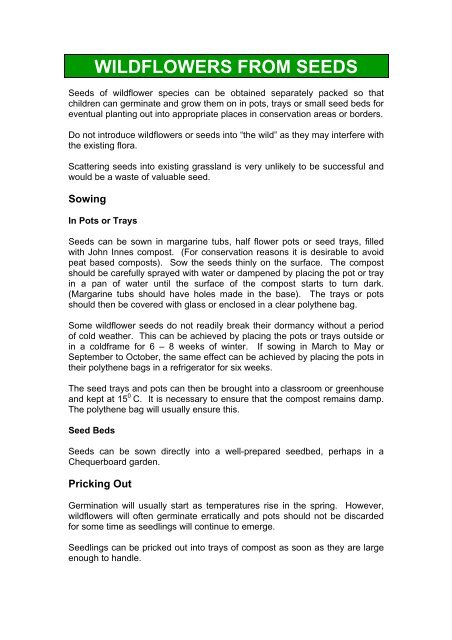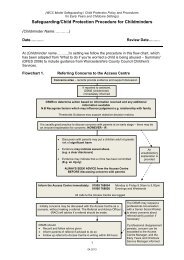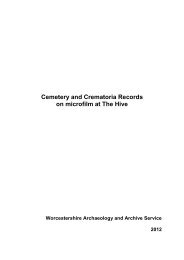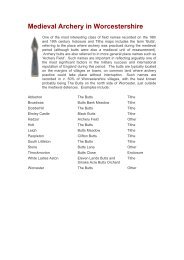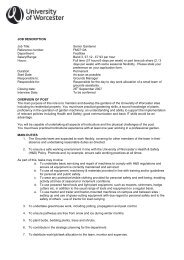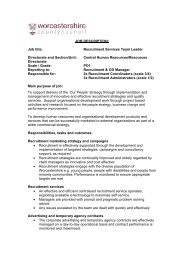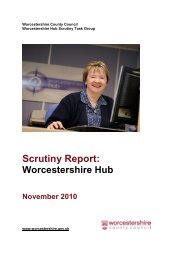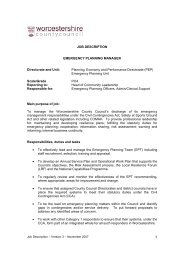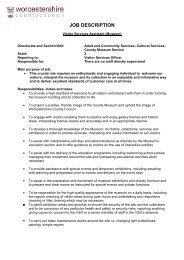WILDFLOWERS FROM SEEDS
WILDFLOWERS FROM SEEDS
WILDFLOWERS FROM SEEDS
You also want an ePaper? Increase the reach of your titles
YUMPU automatically turns print PDFs into web optimized ePapers that Google loves.
<strong>WILDFLOWERS</strong> <strong>FROM</strong> <strong>SEEDS</strong>Seeds of wildflower species can be obtained separately packed so thatchildren can germinate and grow them on in pots, trays or small seed beds foreventual planting out into appropriate places in conservation areas or borders.Do not introduce wildflowers or seeds into “the wild” as they may interfere withthe existing flora.Scattering seeds into existing grassland is very unlikely to be successful andwould be a waste of valuable seed.SowingIn Pots or TraysSeeds can be sown in margarine tubs, half flower pots or seed trays, filledwith John Innes compost. (For conservation reasons it is desirable to avoidpeat based composts). Sow the seeds thinly on the surface. The compostshould be carefully sprayed with water or dampened by placing the pot or trayin a pan of water until the surface of the compost starts to turn dark.(Margarine tubs should have holes made in the base). The trays or potsshould then be covered with glass or enclosed in a clear polythene bag.Some wildflower seeds do not readily break their dormancy without a periodof cold weather. This can be achieved by placing the pots or trays outside orin a coldframe for 6 – 8 weeks of winter. If sowing in March to May orSeptember to October, the same effect can be achieved by placing the pots intheir polythene bags in a refrigerator for six weeks.The seed trays and pots can then be brought into a classroom or greenhouseand kept at 15 0 C. It is necessary to ensure that the compost remains damp.The polythene bag will usually ensure this.Seed BedsSeeds can be sown directly into a well-prepared seedbed, perhaps in aChequerboard garden.Pricking OutGermination will usually start as temperatures rise in the spring. However,wildflowers will often germinate erratically and pots should not be discardedfor some time as seedlings will continue to emerge.Seedlings can be pricked out into trays of compost as soon as they are largeenough to handle.
The young plants can be grown on in the classroom or greenhouse and, whenof reasonable size, can be planted into plastic cups or yoghurt cartons ofpotting compost (make sure there is a drainage hole). These can behardened off outside. Alternatively, small plants can be transplanted into asquare of a Chequerboard garden until large enough to plant out into theirfinal site.Specific RequirementsA – Cornfield AnnualsThese are best transplanted directly from seed trays or seedbeds into theirfinal site by May or thinly sown directly into a seedbed where they can remainto flower.B – Border/Chequerboard GardenThese can be planted out from pots when well grown. They will be attractivein borders and many will attract birds and butterflies.C – HedgerowThese can be planted out when well grown into a suitable site using a bulbplanter. They should be planted out in early May or late September – Octoberand will require watering during dry weather in their first summer.D – WetlandThe seed compost for these seeds should remain moist. Final planting shouldbe into damp ground, perhaps near to a pond or in a wet corner of the schoolfield.
E – GrasslandThese should be grown on in pots and planted out using bulb planters ortrowels into an area intended for a wildflower meadow. Early May or lateSeptember – October are the best times do this and watering will be requiredduring dry weather. Wildflower meadows require a specific mowing regime.Wildlife Seed SuppliersBritish Seed Houses LtdHead Office: Bewsey Industrial Estate, Pitt Street, Warrington, Cheshire.WA5 5LE.BTCV EnterprisesRed House, Great Barr, Birmingham. B43 6LZ.Emorsgate SeedsMiddle Cottage, Emorsgate, Terrington St Clement, King’s Lynn, Norfolk.PE34 4NT.Landlife WildflowersNational Wildflower Centre, Court Hey Park, Liverpool. L16 3NA.Really Wild FlowersHigh Value Horticulture plc, The Shop, The Street, Sutton Waldron, BlandfordForum, Dorset. DT11 8NZWWW Johnson & Son LtdLondon Road, Boston, Lincs. PE21 8AD.Wildlife Habitats for School Grounds.© Bishops Wood Centre School Grounds Service 2005.www.bishopswoodcentre.org.uk 01299 250513


